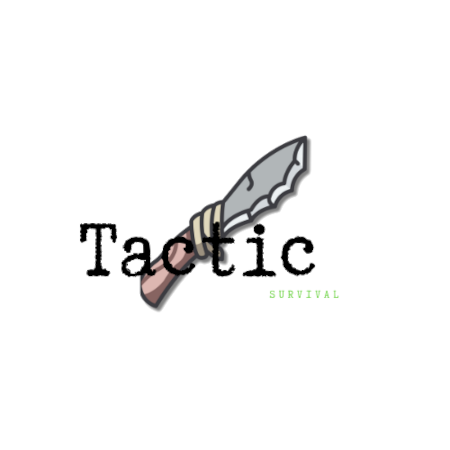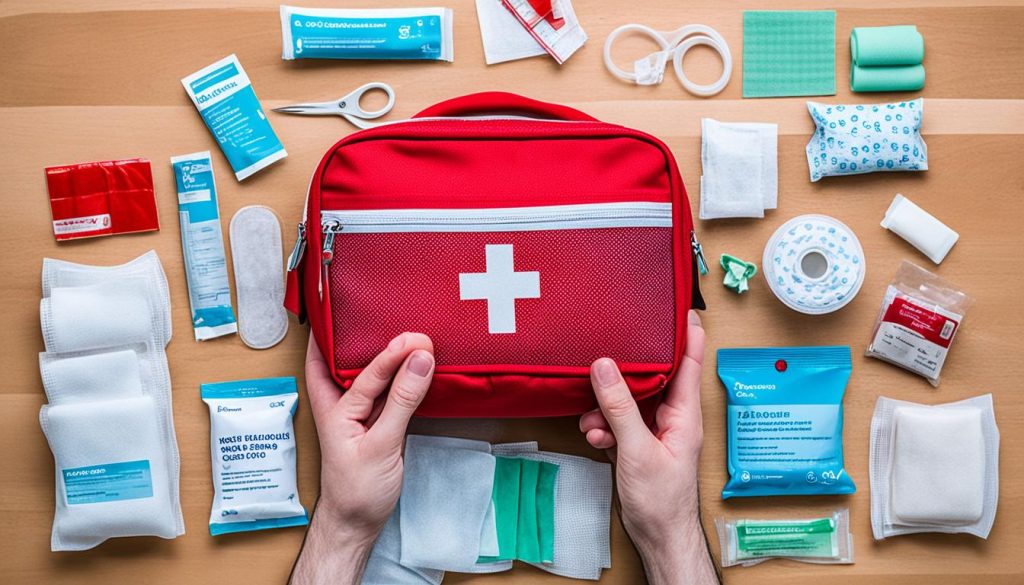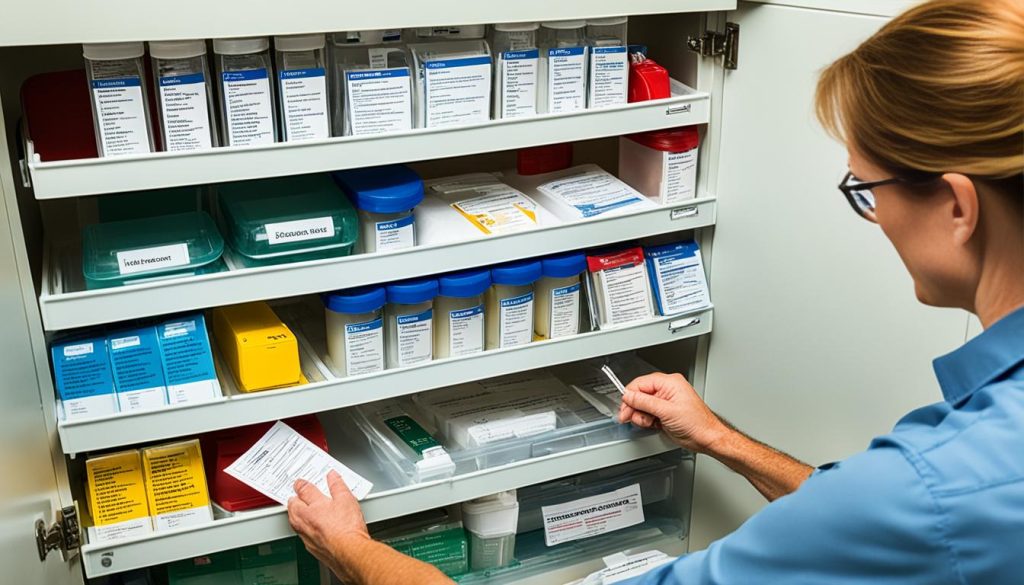Did you know that over 39 million injuries need medical attention in the United States each year? These injuries range from small cuts to major accidents. By having the right supplies, you can save lives and lower risks. That’s why it’s crucial to have your own emergency medical kit. It helps you be ready for any emergency, at home, in your car, or at work.
Key Takeaways:
- Building your own emergency medical kit is essential for being prepared for any emergency situation.
- Having a well-stocked first aid kit can save lives and prevent further complications.
- Whether you’re at home, in your car, or at work, it’s important to have the necessary supplies on hand.
- By following the steps outlined in this guide, you’ll be ready to handle any medical emergency that comes your way.
- Don’t wait until it’s too late, start building your own emergency medical kit today.
The Importance of a Well-Stocked First Aid Kit
A well-stocked first aid kit is crucial for medical emergencies. When seconds count, it could save a life. With it, you can offer important care until help arrives.
Picture this: someone at home has a sudden injury. With your kit, you’re ready to help them. It’s your first step in emergency care.
It’s vital for many health issues to have the right medical supplies nearby. Things like bandages and gloves are essential. They let you help until a doctor can.
Having a good first aid kit also gives peace of mind. It means you’re ready for surprises. This is key for trips or outdoor fun, where medical help is not close.
| Medical Supplies | Quantity |
|---|---|
| Adhesive bandages (assorted sizes) | 20 |
| Gauze pads | 10 |
| Sterile dressings | 5 |
| Triangular bandages | 2 |
| Antiseptic wipes | 10 |
| Tweezers | 1 |
| Scissors | 1 |
| Disposable gloves | 5 pairs |
| Pain relievers | 1 bottle |
| Antihistamines | 1 box |
| Emergency blanket | 1 |
| CPR mask | 1 |
| First aid manual | 1 |
You never know when you’ll need a first aid kit. It’s wise to keep it updated. This way, you’re always prepared for the unexpected.
Stay tuned for Section 3 to learn more about choosing the right supplies for your emergency medical kit.
Choosing the Right Supplies for Your Emergency Medical Kit
Choosing the right supplies for your emergency medical kit is very important. You need to have the right things to look after medical issues. It’s crucial for your home, car, or workplace. Knowing what to pack matters a lot.
Key medical supplies for your kit include:
- Bandages and dressings: You must have these for cuts, wounds, and injuries. Add adhesive bandages, gauze, tape, and elastic bandages for good wound care.
- Antiseptics: Wipes or solutions keep wounds clean. Pack alcohol wipes, hydrogen peroxide, or sprays to fight off infection.
- Medications: Have basic meds like pain relievers and antihistamines. Always ask your doctor before adding any prescription drugs.
- Tools: Don’t forget scissors, tweezers, and a thermometer. They’re useful for many medical tasks.
Think about what you and your family might need besides these general items. Include special meds, allergies, and health conditions.
Recommended Supplies for Specific Situations
Some emergencies require unique supplies. Here are some suggestions for different scenarios:
| Scenario | Recommended Supplies |
|---|---|
| Allergy-related emergencies (e.g., severe bee sting) | EpiPen or other prescribed emergency medication, antihistamines |
| Respiratory issues (e.g., asthma) | Rescue inhaler, spare nebulizer masks, prescribed medications |
| Chronic medical conditions (e.g., diabetes) | Insulin, glucose tablets, test strips, spare syringes |
| Outdoor activities or camping | Snake bite kit, tick removal tool, sunscreen, insect repellent |
By arranging supplies for your specific needs, you’re better equipped for emergencies.
Storing and Organizing Your Emergency Medical Kit
After you get all your supplies, you must store and organize them well. Pick a container or bag that’s tough and easy to find. Label it clearly.
Keep your kit in a cool, dry spot. Make sure all meds are not expired. Replace anything that goes bad right away.
Having a well-stocked kit is crucial for sudden health issues. The right supplies mean you can help fast and get the best results in an emergency.
Building Your Own Emergency Medical Kit
First aid kits are important, and you know that. Now it’s time to make your emergency medical kit. You can buy a pre-made one or put it together yourself. Making your own lets you pick exactly what you need and ensures all crucial items are there.
We’ve put together a guide to help you make your kit:
1. Choose a Suitable Container
Find a strong box for your medical supplies. It should be big and have places to keep everything organized.
2. Organize Your Supplies
Start by putting things into groups like bandages, meds, tools, and gear to keep you safe. This makes it simple to find what you need quickly.
3. Include Essential Medical Supplies
Make sure your kit has what’s really important. This includes things like:
- Bandages (adhesive, gauze, and elastic)
- Antiseptic wipes or solution
- Antibiotic ointment
- Pain relievers
- Tweezers and scissors
- Disposable gloves
Don’t forget to add anything you might need for special health concerns or if anyone has allergies.
4. Check for Expiration Dates
Keep an eye on expiration dates for meds and other items. Swap them out when they’re old to keep your kit ready to use.
5. Store Your Kit in a Convenient Location
Keep your kit somewhere easy to get to in an emergency. Make sure everyone who needs to know is aware of its location.
6. Make a Checklist
Make a list of everything in your kit to help you keep it updated. This will remind you what to replace and make sure you never run out of anything you need.
Following this advice will help you make a great emergency kit. It will be ready to face whatever challenges come your way.
Regularly Checking and Replenishing Your Emergency Medical Kit
Building your emergency medical kit is just the start. You must also check and update your supplies. This ensures your kit is always ready for any health crisis. Make sure all items are in date, working, and easy to reach. Keep your stock of supplies up so that you’re fully prepared.
Items in medical kits can expire or run out, making them less useful. Keep an eye on expiry dates and refresh anything out of date. Regular checks help you see what needs restocking. A full kit means you can help right away if there’s an emergency.
Guidelines for checking your emergency medical kit:
- Inspect your first aid kit at least every six months to ensure it’s current.
- Check the expiration dates of all medications, ointments, and other supplies.
- Take note of any supplies that have been used up or need replacement.
- Verify that all tools, like scissors and tweezers, work well.
By checking your kit often, you can spot what’s missing and fix it. Keeping it in top shape makes it a trusty tool for you and your loved ones. This ensures you’re ready for any health scare.
Emergency kits can wear out over time. But, with regular upkeep, you can rely on yours. Stay ahead by keeping your supplies fresh. Then, you can face any emergency with confidence.
Additional Considerations for Your Emergency Medical Kit
When creating your emergency medical kit, think beyond the basics. It’s about tailoring the kit for your own needs. Think about what might be needed in your specific situation. Here are some extra things to keep in mind:
Specialized Medical Supplies
If you have a specific health issue, consider including some special supplies. This might be medicine for certain illnesses or tools for unique needs. Here are a few examples:
- An EpiPen for severe allergic reactions
- Insulin and blood glucose monitoring supplies for diabetics
- An emergency breathing mask for individuals with respiratory conditions
- A tourniquet for severe bleeding
Think about your own health and your family’s when picking out these supplies.
Also, remember to check the expiration dates on these items. Make sure to swap them out when necessary. This keeps your supplies ready for an emergency.
Personal Medications and Medical Conditions
For those with ongoing medical needs, make sure to pack enough medicine. Include items like:
- Prescription medications
- Over-the-counter medications for chronic conditions
- Medical equipment for monitoring or managing a specific condition
Talk to your doctor. They can help figure out how much medication to include. This ensures you’re ready for any long-lasting emergency.
Don’t forget to have an updated list of medical issues and allergies. This is crucial for first responders. It helps them give the best care quickly.
Emergency Contact Information
Include a list of important phone numbers in your kit. This should have family, doctors, and others who need to know. Keep this list safe, either written or on an electronic device in a waterproof case.
Remember, a good emergency medical kit prepares you for many situations. By adding things like special medications and important numbers, you’re making sure it fits your unique needs.
Conclusion
Creating your own emergency medical kit is vital. It prepares you for any urgent health situation. By picking the correct items and making a complete first aid kit, you’ll be ready for various medical needs. Always check your kit and add new supplies to keep it ready for use.
Your advanced first aid kit brings peace of mind. It makes you ready to manage any health crisis at home, during travel, or work. The right tools and preparation are key. They enable you to give immediate care until professionals can help.
Now is the time to act. Build your emergency medical kit following this guide. Gathering the necessary items is the first step. Prepare your first aid kit in advance. It ensures you can handle sudden medical needs swiftly, possibly even saving lives.


